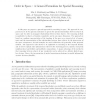Free Online Productivity Tools
i2Speak
i2Symbol
i2OCR
iTex2Img
iWeb2Print
iWeb2Shot
i2Type
iPdf2Split
iPdf2Merge
i2Bopomofo
i2Arabic
i2Style
i2Image
i2PDF
iLatex2Rtf
Sci2ools
89
Voted
ICTAI
1996
IEEE
1996
IEEE
Order in Space: A General Formalism for Spatial Reasoning
In this paper we propose a general approach for reasoning in space. The approach is composed of a set of two general constraints to govern the spatial relationships between objects in space, and two rules to propagate relationships between those objects. The reasoning method is applicable to objects of random complexity and in any space dimension. The approach is based on a uniform representation of the topology of the space as a connected set of components and the representation of the relationships between those objects by the intersection of the space components. Several examples are used to illustrate the generality of the proposed method. The approach is also shown to be applicable to reasoning in the temporal domain and is used to explain some phenomenon related to the reasoning process, namely, conceptual neighbourhood and de nite and inde nite compositions. A major advantage of the method is that reasoning between objects of any complexity can be achieved in a de nite limited ...
Artificial Intelligence | ICTAI 1996 | Reasoning | Reasoning Method | Spatial Reasoning Mechanisms |
Related Content
| Added | 07 Aug 2010 |
| Updated | 07 Aug 2010 |
| Type | Conference |
| Year | 1996 |
| Where | ICTAI |
| Authors | Baher A. El-Geresy, Alia I. Abdelmoty |
Comments (0)

